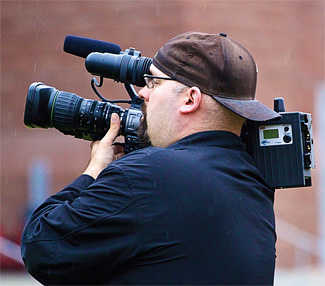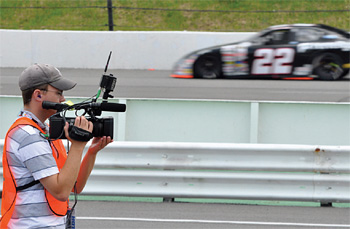Options Expand for ENG
ALEXANDRIA, VA
Whether for an IP back haul or getting a live shot from a moving vehicle, the use of IP video transmission systems is changing the game for everything from live remotes to station infrastructure.

DSI RF Systems recently introduced the NewsShark Camera bolt-on. “Broadcasters who are really successful using IP have been those with a good understanding of IP technology and who have been innovative with its implementations,” said Ben Larson, a technical project manager for Seattle-based Streambox. Larson works with clients to better educate them on the options IP video can bring to the table.
There is no shortage of ENG video acquisition options available today, including IP. However, traditional satellite and microwave systems are still advancing with new efficiencies in signal transmissions that improve every year.
“Even older technologies are still evolving, with satellite and microwave systems not standing still by any means,” said Jack Vickers, senior product manager for decoder vendor Sencore in Sioux Falls, SD. Vickers explained that the efficiencies are developing on two fronts; compression technology keeps pushing down bandwidth requirements and modulation schemes keep getting more efficient. This means that every year more channels can be transported within the same spectrum space at higher resolutions. With spectrum becoming scarcer, this development is of major importance to broadcasters.
Advances in both IP video and microwave/satellite gear make it even more important when determining which new system offers a significant enough ROI or competitive edge.
IP’S COMPETITIVE EDGE
Whether as a briefcase, backpack, or even a camera bolt-on device, news organizations around the world can now go live with good quality video from almost anywhere they can get Internet connectivity. This connectivity is made available from 3G/4G cell systems, WiFi hotspots and of course, Broadband Global Area Network (BGAN) satellite terminals.
In the past wireless video from the field consisted of portable microwave links from a camera-based transmitter back to a truck which then retransmitted the signal to the station. These setups provided roaming ability for the camera, but were restricted by the typical line of sight and distance constraints of small microwave radio transmitters.
The trend today is to develop small portable devices that can stream IP video from a camera over whatever Internet connectivity is available. These signals are sent to decoders back at a station and then decoded into baseband video. The greatest benefit of these devices is the ability to physically take the live shot almost anywhere, un-tethered from traditional cabling or microwave links.
“Many local stations are now using IP video, where before it was the worst case scenario option,” said Larson. Having been in the IP streaming business for many years, Streambox has taken its fixed networks technology and adapted it for use in the company’s new Avenir system, which can take advantage of integrated cellular modems as well as attach to other sources of IP connectivity including BGAN terminals. Like many of the other new products out this year it can take advantage of using multiple cellular or satellite modems from multiple carriers to provide greater bandwidth with more dependability.
One lightweight option now available the NewsShark camera bolt-on option from Somerset, N.J.-based DSI RF Systems. Designed with news in mind, and with IFB feeds for talent and camera operator, this unit can be a great addition to an ENG van’s tool kit and can even turn a reporter’s car into an ENG option.

IMT’S microLite HD transmitter in use at Pocono Raceway. Each of the new portable IP products offers differing ROI and competitive options. Broadcasters considering this technology need to look closely at the deployment application. Some products offer higher resolutions, up to full HD, where others have more than just air cards and can take advantage of other multiple connectivity options. Some manufacturers also offer a store and forward option where a streamed version can be sent on available bandwidth, and a higher resolution can be sent back later as a file for editing.
Physical packaging is also very important. For one-man-band crews, the backpack and camera bolt- on options make the most sense, whereas an overseas crew might like a more rugged case-based platform. The costs vary as drastically as do the options. There is a product for every budget, and in some cases this may be the overriding factor. Whatever the considerations, having these tools available can open up totally new options for live ENG coverage. Just as the Gyro stabilized helicopter camera revolutionized aerial coverage for news, these products will create a sea change in ground coverage.
TRADITIONAL DOESN’T MEAN LIMITED
While new IP-based systems are beginning to offer acquisition flexibility once only dreamed of, the traditional ENG workhorses of terrestrial microwave and satellite by no means have relinquished their importance. Today QPSK and 8PSK modulation schemes and advances in MPEG compression allow multiple channels and even HD in the bandwidth once allocated to only a single analog signal. This extra capacity keeps product manufacturers like Sencore optimistic about the technology. “Most of our customers see IP over satellite as unnecessary overhead,” said Vickers. He believes the adoption of even more advanced modulation schemes such as 16APSK and even 32APSK will continue to solidify digital satellite transmission as the premier resource for high-quality broadcast video acquisition and distribution.
The professional video industry's #1 source for news, trends and product and tech information. Sign up below.

